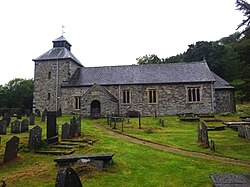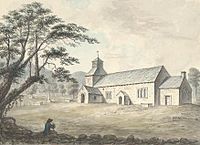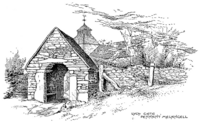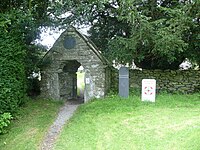St Melangell's Church
| St Melangell's Church | |
|
Pennant Melangell, Montgomeryshire | |
|---|---|
| Status: | Parish church |
 St Melangell's Church and churchyard | |
| Church in Wales | |
| Diocese of St Asaph | |
| Parish: | SJ024265 |
| Location | |
| Grid reference: | SJ024265 |
| Location: | 52°49’39"N, 3°26’59"W |
| History | |
| Information | |
| Website: | https://stmelangell.org |
St Melangell's Church is an ancient church in Montgomeryshire. It belongs to the Church in Wales, in the Diocese of St Asaph. The church is in the former village of Pennant Melangell, in the Tanat Valley
The church is a Grade I listed building.[1]
The church was founded around the 8th century to commemorate the reputed grave of Melangell, a hermit and abbess who founded a convent and sanctuary in the area. The current church was built in the 12th century, and the oldest documentation of it dates to the 13th century. The building was renovated several times, including major restoration work in the 19th and 20th centuries. In the 1980s, the church was in danger of demolition, but under new leadership, it was renovated, and a cancer ministry was started. In 1958, and again between 1987 and 1994, the site was subject to major archaeological excavations, which uncovered information about prehistoric and mediæval activity at Pennant Melangell, including evidence of Bronze Age burials.
St Melangell's Church contains the reconstructed shrine to Melangell, considered the oldest surviving Romanesque shrine in northern Europe. The shrine dates back to the 12th century and was a significant centre of cult activity in Wales until the Reformation. It was dismantled at some point, probably in the early modern era, and reconstructed in 1958 out of fragments in and around the church. In 1989, the shrine was dismantled again and restored in 1991, according to newer scholarship. Pennant Melangell has continued to attract pilgrims of various backgrounds and motivations into the 21st century.
The church is built of several types of stone and has a single nave and a square tower. On the east end is an apse, known as the Cell-y-bedd or 'grave chamber', which contains Melangell's traditional grave. The interior of the church holds historically valuable objects, including a 15th-century rood screen depicting Melangell's legend, two 14th-century effigies, paintings, and liturgical fittings.
Contents
History
The site of St Melangell's Church held spiritual significance as far back as the Bronze Age. It was probably turned into a Christian site by Celtic Christians of the early mediæval period. [2] Archaeological evidence of cremation pyres suggests that there was a burial mound at Pennant in the Bronze Age, possibly under the church itself. Bronze Age pottery and early mediæval burial activity have also been discovered, indicating the site's use as a burial ground until the church's construction. [3]
Mediæval period
According to her hagiography, Historia Divae Monacellae, Melangell sought refuge at Pennant after fleeing an arranged marriage in her native Ireland. She spent 15 years in solitude without seeing a man until a prince named Brochwel discovered her. The prince, pursuing a hare with his dogs, encountered Melangell praying with the hare safe under her hem. Brochwel granted her the land with perpetual sanctuary rights for anyone fleeing to Pennant, and Melangell went on to found a community of nuns. [4]
Pennant Melangell was probably founded in the late 8th century, and references to abbots in Melangell's hagiography indicate that a male monastic community was later established at the site. Neither the male nor female monasteries remained by the 13th century when the first documentation of the church appeared.[5] Historically, locals of the area refused to kill hares due to their association with Melangell. According to the archaeologist Caroline Malim, the veneration of hares at Pennant probably originates in pre-Christian Celtic religion. [6]
Under Norman rule in the 11th and 12th centuries, the Welsh Church was reformed. Saints' cults were revived and Normanised, The current stone church was built in the 12th century, probably over an earlier mediæval graveyard, which in turn was built over a Bronze Age burial mound.[7] The shrine to Melangell also dates to the 12th century, and was probably locally crafted[8] under Norman influence.[9] According to the historian Kathryn Hurlock, the shrine was erected around 1160–1170 to house Melangell's translated remains, and the 12th-century apse enclosed her original grave.[10]
The church may have been built by Rhirid Flaidd,[11] a nobleman who, according to tradition, inherited Pennant Melangell from his father. The first written records of the Pennant church appear in the Valuation of Norwich of 1254, in which the church property is valued slightly below average for the Diocese of St Asaph. In 1291, however, the church was one of the more valuable churches in the diocese, probably owing to a rise in popularity of Melangell's cult. By the 15th century, the poet Guto'r Glyn records that pilgrims were known to visit the shrine of Melangell for a cure to their ailments.[12] The entire roof was probably replaced in the 15th century, and the current rood screen was added.[13] An aisle on the south side of the chancel may have been added to aid pilgrims' access to the shrine in the late mediæval period.[14]
Reformation and aftermath
Melangell's cult remained popular until the Reformation; in 1535 the income from offerings at the shrine was comparable to that of other major cult centres in Wales.[15] In the summer of 1535, Henry VIII sent preachers and officials to the Diocese of St Asaph to promote reform. Pilgrimage and saints' cults ceased, which brought major changes to the fabric of the church; the shrine was probably dismantled at this time and the grave chapel blocked off. Portions of the shrine were incorporated into the walls of the church and the lychgate, which was built in the 17th century.[16]
Significant repairs and renovations were undertaken throughout the 18th century, including blocking up doors and windows, building a new porch, replacing walls, and possibly dismantling the loft of the rood screen. The old cell-y-bedd was also built at this time, replacing the mediæval apse and grave chapel. It was probably built as a schoolroom, and was also used as a vestry.
Rebuilding
The current church tower was built during restoration work in 1876–1877, replacing the previous tower of unknown age.[17] In 1878 new pews and a new altar table were added, and in honour of the restoration a yew tree was planted in the churchyard.[18] St Melangell's Church was transferred to the parish of Llangynog in 1878, and in 1886 the adjacent rectory and vicarage were sold.[19]
After the 19th-century restoration work, the church largely remained in obscurity, and the building deteriorated. With a diminishing congregation, funds were scarce. There were suggestions that it be demolished entirely. In 1958 the cell-y-bedd was repaired, and the shrine was reconstructed based on a design by the archaeologist Ralegh Radford.
By the 1980s the church had once again deteriorated and was in danger of demolition. At the same time, Paul Davies, the parish priest of Meifod, bought a cottage near the church with his wife following her recovery from cancer. Davies was licensed by the diocese to look after the church on a voluntary basis; under his care, a cancer help centre was started out of their cottage and a complete restoration was undertaken.[20] Work began in 1989, during which the apse was rebuilt and the shrine moved to the chancel. Electricity was installed in the church for the first time during the restoration.
Architecture
The church has a single nave, with a chancel and apse at the east end, and a tower at the west end. The building is constructed of waterworn pebbles, larger slabs of sedimentary rock, and blocks of shale; different portions of the church date to varying periods, from the 12th to the 20th centuries. The main roof is of slate with stone ridge tiles, and the roof of the porch is black ceramic tile. The 19th-century square tower has a pyramidal roof topped by a short timber belfry.[11] The current bell is dated to 1918 and was made by the Taylors of Loughborough.[21]
Outside links
| ("Wikimedia Commons" has material about St Melangell's Church) |
References
- ↑ Site details: St Melangell's Church (RCAHMW)
- ↑ Keulemans & Burton 2006, pp. 105–106.
- ↑ Britnell 1994b, pp. 90–92.
- ↑ Pryce 1994, p. 23.
- ↑ Ralegh Radford & Hemp 1959, p. 85.
- ↑ Malim 2018, p. 98.
- ↑ Heaton & Britnell 1994, p. 105.
- ↑ Britnell & Watson 1994, p. 147.
- ↑ Fenn & Sinclair 1990, p. 63.
- ↑ Hurlock 2018, p. 23.
- ↑ 11.0 11.1 "Montgomeryshire Churches Survey: Church of St Melangell, Pennant Melangell". Clwyd-Powys Archaeological Trust. https://cpat.org.uk/Archive/churches/montgom/19470.htm.
- ↑ Heaton & Britnell 1994, pp. 103–104.
- ↑ Heaton & Britnell 1994, p. 111.
- ↑ Ralegh Radford & Hemp 1959, pp. 103–104.
- ↑ Heaton & Britnell 1994, pp. 104–105.
- ↑ Heaton & Britnell 1994, p. 113.
- ↑ Heaton & Britnell 1994, p. 114.
- ↑ Britnell 1994b, p. 44.
- ↑ Britnell 1994a, p. 8.
- ↑ Keulemans & Burton 2006, p. 101.
- ↑ Ridgway 1994, p. 137.
- Pennant, Thomas (1810). Tours in Wales. 3. Wilkie and Robinson. https://books.google.com/books?id=WnQ_AQAAMAAJ&pg=PA173.
- John Parker (cleric) (October 1848). "Pennant Melangell, Montgomeryshire. No. II". Archaeologia Cambrensis 3 (12): 224–228. SSN 0306-6924.
- "Pennant Melangell, Miscellaneous Notices". Archaeologia Cambrensis. 4 (32). October 1877. SSN 0306-6924.
- Crossley, Fred H.; Ridgway, Maurice H. (1947). "Screens, Lofts, and Stalls Situated in Wales and Monmouthshire: Part Five - Montgomeryshire". Archaeologia Cambrensis 99 (1): 179–230. SSN 0306-6924.
- Jones, Francis (1954). The Holy Wells of Wales. Cardiff: University of Wales Press. ISBN 9780708311455.
- Ralegh Radford; Hemp, W. J. (1959). "Pennant Melangell: The Church and the Shrine". Archaeologia Cambrensis 108: 81–113. SSN 0306-6924.
- Fenn, R. W. D.; Sinclair, J. B. (1990). "The Christian Origins of Montgomeryshire: an Interpretation". Montgomeryshire Collections 78: 47–64. SSN 0144-0071.
- Walker, David (1990). "The Normans in Wales". Mediæval Wales. Cambridge University Press. doi:10.1017/CBO9781139167888. ISBN 9781139167888.
- Williams, Glanmor (1993). Renewal and Reformation: Wales c.1415–1642. Oxford University Press. doi:10.1093/acprof:oso/9780192852779.001.0001. ISBN 9780191670558.
- Britnell, W. J. (1994a). "Boundaries of the Parish of Pennant Melangell". Montgomeryshire Collections 82: 1–8. SSN 0144-0071.
- Evans, G. G. (1994). "Place-names and Field-names of Pennant Melangell". Montgomeryshire Collections 82: 9–22. SSN 0144-0071.
- Pryce, Huw (1994). "A New Edition of Historia Divinae Monacellae". Montgomeryshire Collections 82: 23–40. SSN 0144-0071.
- Britnell, W. J. (1994b). "Excavation and Recording at Pennant Melangell Church". Montgomeryshire Collections 82: 41–102. SSN 0144-0071.
- Heaton, R. B.; Britnell, W. J. (1994). "A Structural History of Pennant Melangell Church". Montgomeryshire Collections 82: 103–126. SSN 0144-0071.
- Ridgway, Maurice H. (1994). "Furnishings and Fittings in Pennant Melangell Church". Montgomeryshire Collections 82: 127–138. SSN 0144-0071.
- Parkinson, A. J. (1994). "Paintings and Inscriptions in Pennant Melangell Church". Montgomeryshire Collections 82: 139–146. SSN 0144-0071.
- Britnell, W. J.; Watson, K. (1994). "Saint Melangell's Shrine, Pennant Melangell". Montgomeryshire Collections 82: 147–166. SSN 0144-0071.


